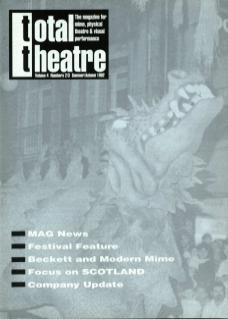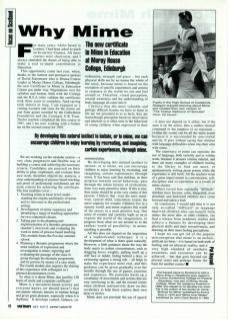For many years, whilst based in London, I had been asked to teach on In-service Courses. All these courses were short-term, and I always cherished the dream of being able to make a real in-depth contribution to Education.
This opportunity came last year, when, thanks to the interest and persuasive powers of David Starsmeare, who is Drama Course Leader at Moray House College, Edinburgh, the new Certificate in Mime in Education Course got under way. Negotiations over the syllabus and format, both with the College and the R.S.A. (who validate the certificate) took three years to complete: fund-raising took almost as long. I am engaged as a visiting Lecturer and costs for the course are met from grants awarded by the Gulbenkian Foundation and the Carnegie UK Trust. Twelve teachers completed the first course in 1991, and I am now working with a further ten on the second course for 1992
We are working on the modular system – a very clear, progressive and flexible way of building a course and achieving the necessary criteria. Candidates are assessed on their ability to plan, implement, and evaluate their own work, therefore objectivity, analysis, a clear understanding of process based teaching, and proof of professional enrichment are the main criteria for achieving the certificate. The four modules cover:
1. Teaching mime at basic level; understanding the origins and history of mime and its relevance to the professional setting.
2. Development of mime sequences and identifying a range of teaching approaches for two contrasted classes.
3. Taking part in the planning and implementation of a thematic programme (teacher's own level) and evaluating the work in terms of process based teaching. This module forms the five-day summer school.
4. Planning a thematic programme where the main medium of expression and investigation is mime; reporting and evaluating the passage of the class or group through the thematic programme and its process by means of a case study.
The fourth module also requires the sharing of this experience with colleagues in a planned dissemination event.
So what is it about Mime that justifies 120 hours of study and a separate certificate? Mime is a movement-based activity and everyone knows (or should know!) that movement releases tension in human beings and gives great pleasure, especially when it is rhythmic. It develops control, balance, coordination, strength and grace – but such physical skills are by no means the whole of the story, because mime is based on the recreation of specific experiences and actions in response to the world we see and feel around us. Therefore, visual perception, sensual awareness and the understanding of body language all come into it.
By developing this natural instinct to imitate, or to mime, we can encourage children to enjoy learning by recreating, and imagining, certain experiences, through mime.
I believe that the most valuable and perhaps difficult lessons we have to learn in life are not presented to us as facts: they are learnt though perception based on observation and intuition as is often seen in the behaviour of young children when engrossed in their untutored play.
By developing this natural instinct to imitate, or to mime, we can encourage children to enjoy learning by recreating, and imagining, certain experiences, through mime. It has been said that children, in their progress towards social behaviour, pass through the whole history of civilisation, from very early primitive times. If this is true, then mime should be at the very centre of this process. I believe that even the most streetwise, cynical child, somewhere retains the naive capacity for wonder. Children live in a sensory world, and mime explores this world of the senses in a most positive way. Our sense of wonder and curiosity leads us on to explore the world of the imagination, to progress from what we see around us to the endless world of possibility: in mime, anything is possible.
All this does not depend on the imposition of a sophisticated technique: it is a development of what is there quite naturally. However, a little guidance about the way the body reacts to certain circumstances, such as dragging heavy weights, pulling itself up a cliff face or ladder, hiding behind a door, or swimming against a strong tide – all helps to make the experience more real, and this guidance can be given gradually over the months through the use of games, exercises and sequences. We patiently build up a vocabulary of movements and actions that are very convincing to do, and the reward comes when children instinctively draw on this vocabulary to help them explore their own ideas or stories.
Mime does not preclude the use of speech – it does not depend on it either, but if the onus is on the action, then a sudden shouted command or the eruption of an argument (within the scene) can be all the more potent because it is surrounded by non-verbal activity. It goes without saying that children with language difficulties come into their own with mime.
The experience of mime can stimulate the use of language, both verbally and in written work, because it arouses intense interest, and there are many examples of children rushing to the library to find out more, or spontaneously writing prose poems while the experience is still fresh. All the teachers write of a great improvement in concentration, self-discipline and cooperation as a result of mime classes.
Others record how reputedly difficult children have become calm, integrated, even absorbed, and backward children have come forward and taken a lead.
In conclusion, I would add that it is not only so-called ‘difficult’ or language deprived children who can benefit from mime; the more able, or older children, can find a release from academic studies and achieve a balance by developing their physical skills and their inventiveness, and drawing on their more feeling perceptions.
I hope we can get rid of the popular misconception that mime is an archaic, artificial artform – it is based on both truth of feeling and on physical reality, and a very high standard of aesthetic awareness and execution can be achieved, but that goes beyond our present remit and perhaps forms the basis for another course!
Pat Keysell came to Scotland to fulfil a Mime Artist in Residence post, based in the former Dunfermline College of Physical Education, now part of Moray House College. When the residency finished in 1988, she stayed on to develop her work. Pat is the author of two books on mime: Motives for Mime published by Evans Bros in 1975 and Mime Over Matter published by John Clare Books in 1990.

